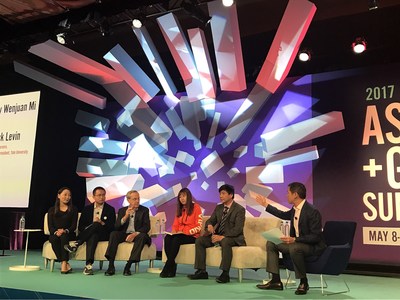TMCnet News
China and the US Look Forward to New Exchanges on Education Following ASU GSV SummitSALT LAKE CITY, May 24, 2017 /PRNewswire/ -- The 2017 ASU GSV Summit wrapped up its eighth annual session on May 10 in Salt Lake City with over 3,000 educators, policy makers and investors in attendance. Making a strong presence in its second year at the Summit was the EdStars Educational Delegation led by TAL Education and its EdStars division, which supports a network of top educational leaders in China. This year's group included 17 EdStars members and over 30 education CEOs and officials.
The Chinese companies in attendance received a warm welcome at this year's Summit, partly due to a diverse program selection offered by the EdStars Educational Delegation. Two panels of leading Chinese education companies presented to fully-packed rooms. Former Yale University president and Coursera CEO Rick Levin joined TAL Education co-founder Liu Yachao and other leading voices in Chinese education in a keynote discussion on US-China education exchange and integration. Attendance at a poolside cocktail reception for Chinese and international edtech enterprises was double expectations. Many foreign CEOs even learned to use WeChat, China's ubiquitous messaging app, to keep in contact with Chinese companies. The rapid growth of the Chinese education market in recent years was undoubtedly another reason for the great interest in the Chinese companies. Valued at RMB 1.6 trillion in 2015, the industry is expected to grow to RMB 3 trillion by 2020. Additionally, more than half of all investments were in the early childhood and K12 tutoring markets. This expansion has been fueled in part by new governent policies favorable to the education industry. TAL Education CSO and general manager of the investment division John Wu also cited increased birthrate (20 million births expected per year from 2016 to 2020), a desire for more diversified education from young parents, and a rising demand for quality STEAM education as drivers of this trend. Mr. Wu admitted that both the public sector and private companies like TAL Education struggle to supply enough teachers and services to fill the needs of the voracious market. Aside from its scale, Dr. Levin noted in a keynote speech with Dr. Liu and VIPKID CEO Cindy Wenjuan Mi that some of the Chinese education market's appeal is that it is "the most mobile intensive" market, with mobile usage at 60 percent compared to 30 or 40 percent in much of the rest of the world. Although the task of providing basic education to every child in the nation is not yet complete, Mr. Wu points out that many schools in rural Tier 4 or Tier 5 cities have skipped over landlines and directly into the mobile internet age, allowing them to benefit from many of the internet-based education innovations of today. Unsurprisingly, how to enter the Chinese education market was the focus of many interactions between Chinese and foreign guests. Dr. Levin, who has considerable experience engaging with China, echoed a sentiment that was expressed by nearly all the Chinese edtech leaders who addressed the issue on the Summit stage: foreign companies need to find a suitable partner in China to help localize content and business models in order to succeed. According to Dr. Levin, Coursera has built a cooperative relationship with numerous well-known Chinese universities and colleges, and it has nearly two million registered users in China. Dr. Liu added that foreign educational institutions cannot enter China by simply introducing hardware, but need quality distribution channels and strong product localization. For example, after introducing Reading A-Z -- a service offering leveled reading materials -- from the US, TAL Education input the platform's published contents into an app that helps Chinese students improve their spoken language through speech recognition technology. The two companies have since been in talks about the possibility of introducing TAL Education's innovations on their products back into the US market. Many of the presentations by companies in the EdStars Educational Delegation also strived to highlight the innovation Chinese enterprises and their capacity as creators of intellectual property. As part of ASU GSV's Global Program, online education company EEO introduced its flagship product, ClassIn, a multi-channel interactive online classroom that uses academic as well as behavior data collected from facial recognition software to improve the learning experience. ClassIn's use of advanced technology was part of a central theme noted at this year's Summit: the integration of education and cutting-edge science and technology with a focus on AI (artificial intelligence). Several participants said that a learning revolution triggered by big data and technologies like AR and VR is moving from concept to reality, and questions about the possibility of AI replacing teachers were in no short supply. On this issue, Wang Yi, CEO of Liulishuo, "China's leading 'AI+Education' company in language learning," said onstage that his company has developed an AI teacher that is three times more effective than a human teacher. Dr. Yi asserted that AI is not meant to replace teachers, but actually allows educators to spend less time doing low value-added work so they can focus more on each student's development. "The Chinese education market is transforming from labor-intensive to capital and technology intensive," said Dr. Liu. "With consumption upgrade and the rise of the middle class, the Chinese population's pursuit of education has changed from 'going to school' to 'receiving good schooling,' with a higher requirement for services." Dr. Liu deems that China's education will provide high-quality services for children through technology and global resources integration. All of these changes in Chinese education will provide many opportunities for educators and entrepreneurs from China and the USA to offer innovative ideas and learn from each other through competition and cooperation. To view the original version on PR Newswire, visit:http://www.prnewswire.com/news-releases/china-and-the-us-look-forward-to-new-exchanges-on-education-following-asu-gsv-summit-300463039.html SOURCE TAL Education Group 
|

